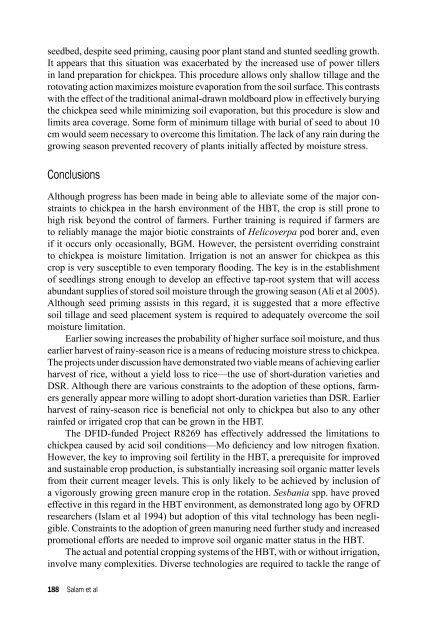Download (2461kB) - University of Greenwich
Download (2461kB) - University of Greenwich
Download (2461kB) - University of Greenwich
- No tags were found...
Create successful ePaper yourself
Turn your PDF publications into a flip-book with our unique Google optimized e-Paper software.
seedbed, despite seed priming, causing poor plant stand and stunted seedling growth.It appears that this situation was exacerbated by the increased use <strong>of</strong> power tillersin land preparation for chickpea. This procedure allows only shallow tillage and therotovating action maximizes moisture evaporation from the soil surface. This contrastswith the effect <strong>of</strong> the traditional animal-drawn moldboard plow in effectively buryingthe chickpea seed while minimizing soil evaporation, but this procedure is slow andlimits area coverage. Some form <strong>of</strong> minimum tillage with burial <strong>of</strong> seed to about 10cm would seem necessary to overcome this limitation. The lack <strong>of</strong> any rain during thegrowing season prevented recovery <strong>of</strong> plants initially affected by moisture stress.ConclusionsAlthough progress has been made in being able to alleviate some <strong>of</strong> the major constraintsto chickpea in the harsh environment <strong>of</strong> the HBT, the crop is still prone tohigh risk beyond the control <strong>of</strong> farmers. Further training is required if farmers areto reliably manage the major biotic constraints <strong>of</strong> Helicoverpa pod borer and, evenif it occurs only occasionally, BGM. However, the persistent overriding constraintto chickpea is moisture limitation. Irrigation is not an answer for chickpea as thiscrop is very susceptible to even temporary flooding. The key is in the establishment<strong>of</strong> seedlings strong enough to develop an effective tap-root system that will accessabundant supplies <strong>of</strong> stored soil moisture through the growing season (Ali et al 2005).Although seed priming assists in this regard, it is suggested that a more effectivesoil tillage and seed placement system is required to adequately overcome the soilmoisture limitation.Earlier sowing increases the probability <strong>of</strong> higher surface soil moisture, and thusearlier harvest <strong>of</strong> rainy-season rice is a means <strong>of</strong> reducing moisture stress to chickpea.The projects under discussion have demonstrated two viable means <strong>of</strong> achieving earlierharvest <strong>of</strong> rice, without a yield loss to rice—the use <strong>of</strong> short-duration varieties andDSR. Although there are various constraints to the adoption <strong>of</strong> these options, farmersgenerally appear more willing to adopt short-duration varieties than DSR. Earlierharvest <strong>of</strong> rainy-season rice is beneficial not only to chickpea but also to any otherrainfed or irrigated crop that can be grown in the HBT.The DFID-funded Project R8269 has effectively addressed the limitations tochickpea caused by acid soil conditions—Mo deficiency and low nitrogen fixation.However, the key to improving soil fertility in the HBT, a prerequisite for improvedand sustainable crop production, is substantially increasing soil organic matter levelsfrom their current meager levels. This is only likely to be achieved by inclusion <strong>of</strong>a vigorously growing green manure crop in the rotation. Sesbania spp. have provedeffective in this regard in the HBT environment, as demonstrated long ago by OFRDresearchers (Islam et al 1994) but adoption <strong>of</strong> this vital technology has been negligible.Constraints to the adoption <strong>of</strong> green manuring need further study and increasedpromotional efforts are needed to improve soil organic matter status in the HBT.The actual and potential cropping systems <strong>of</strong> the HBT, with or without irrigation,involve many complexities. Diverse technologies are required to tackle the range <strong>of</strong>188 Salam et al
















